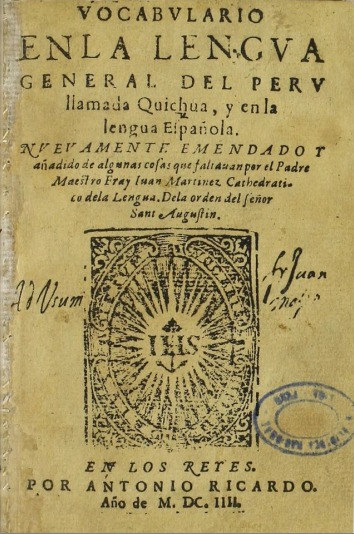
Libraries
Libraries
Vocabulary of the general language of Peru, called Quechua, and of the Spanish languag
The Biblioteca Digital Mundial (World Digital Library in English BDM, WDL) was created in 2009 thanks to an initiative of the Library of Congress of the United States of America and UNESCO. It collects the documentary heritage of humanity in collaboration with libraries around the world. We share the celebrated Vocabulario de la lengua general del Perú (Vocabulary of the General Language of Peru) by the Augustinian friar Juan Martínez, which was reproduced from the copy kept by the National Library of Peru:
Vocabvlario en la lengva general del Perv llamada quichua, y en la lengua española was published in Lima, Peru, in 1604. The book, with more than 400 pages, is an exhaustive dictionary of words in Quechua, the predominant language of the Inca people of South America. The words in Quechua, written according to the phonetics of Latin, are listed in alphabetical order, with their equivalents in Spanish. At the end of the book, a general description of the Quechua grammar appears.
The first South American printing press was established in Lima by Antonio Ricardo (circa 1540-1606), an Italian who had worked for some time as a printer with the Jesuits in Mexico City. This book is part of a collection of 39 first editions of the National Library of Peru, produced in this press between 1584 and 1619.
The collection was incorporated in the Register of the UNESCO Memory of the World Programme in 2013. These books, that are in Latin, Spanish and several Amerindian languages, constitute an important part of the documentation of the 500th Anniversary of the Encounter Between Two Worlds organized by UNESCO in 1992: the Amerindian civilization of the Incas and the European culture represented by the Spanish conquistadors. These documents are important sources for the study of the dissemination of ideas in the Spanish Empire: on the one hand, the process of evangelization and the diffusion of the Catholic religion and, on the other, the debate on native peoples and their status as human beings. Many of the books provide a vision of the political, cultural and social organization of the defeated Inca civilization, as well as a record of the Quechua and Aymara languages spoken by the Incas.

